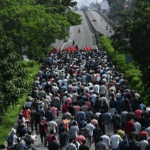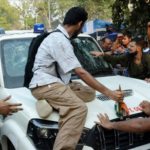1. Introduction: A Tragic Day in Tirupati
Tirupati Stampede , a sacred city revered for the iconic Lord Venkateswara temple, turned into a scene of despair following a tragic stampede that claimed several lives and injured many devotees. The incident occurred during a congregation where thousands of pilgrims had gathered, reflecting the city’s religious and spiritual prominence. The stampede shocked the nation and drew swift responses from political and spiritual leaders.
Among those expressing heartfelt condolences was Congress leader Rahul Gandhi, Tirupati Stampede who described the event as deeply saddening. Gandhi called on Congress workers to extend assistance to the affected families, reinforcing the importance of compassion during times of such tragedy.
This article delves into the tragic incident, its aftermath, Gandhi’s response, and the broader issues surrounding crowd management in religious events.
2. What Happened: Details of the Tirupati Stampede
The stampede unfolded during an annual ritual that attracts millions of devotees to the Tirumala shrine.
- Cause of the Stampede: Preliminary reports suggest overcrowding in a narrow pathway led to panic among devotees. Inadequate crowd management and the rush to perform rituals exacerbated the chaos.
- Casualties and Injuries: Officials confirmed that multiple devotees lost their lives, Tirupati Stampede and several others sustained injuries ranging from minor bruises to critical conditions.
- Emergency Response: Local authorities, temple officials, and disaster response teams rushed to the spot, providing medical aid and assisting with evacuation.
The heart-wrenching scenes of grieving families highlighted the urgent need for improved safety protocols at major pilgrim destinations.  For the more information click on this link
For the more information click on this link
3. Rahul Gandhi’s Reaction: Condolences and a Call for Action
Rahul Gandhi, known for his empathetic approach to national tragedies, promptly expressed his sorrow and extended his support to the affected families.
- Statement on Social Media: Gandhi took to X (formerly Twitter), writing, “The tragic stampede in Tirupati is deeply saddening. My thoughts and prayers are with the victims and their families.”
- Call to Congress Workers: He urged Congress party members, particularly those in Andhra Pradesh, to step up and assist in relief efforts.
- Advocacy for Preventive Measures: While expressing condolences, Gandhi subtly hinted at the importance of learning lessons to prevent similar tragedies in the future, Tirupati Stampede aligning with his commitment to human-centric governance.
His response resonated across political circles, earning praise for its focus on community support over political opportunism.
4. Congress Workers at the Forefront: Relief and Support Efforts
Gandhi’s appeal galvanized Congress workers into action.
- On-Ground Assistance: Local Congress units set up relief camps near hospitals to provide water, food, Tirupati Stampede and emotional support to victims and their families.
- Coordination with Authorities: Congress leaders worked in tandem with local administration to expedite medical care for the injured and assist families in performing last rites for the deceased.
- Volunteer Testimonials: A local Congress worker shared, “Rahul Ji’s call reminded us that service to humanity is our primary duty. We stand with the people of Tirupati in this hour of grief.”
This active participation highlighted the party’s commitment to social responsibility beyond political arenas.
5. Larger Issues Highlighted by the Tragedy
While the immediate focus remained on relief, the incident raised pressing questions about the management of large religious gatherings.
- Overcrowding and Safety Measures: Tirupati’s popularity means constant challenges in managing crowds, particularly during festivals. Critics pointed to lapses in deploying adequate personnel and barriers to regulate the flow of devotees.
- Role of Technology: Despite advancements, many temples lack real-time monitoring systems or automated controls for crowd management.
- Accountability of Authorities: Public scrutiny intensified over local administration’s preparedness, with demands for accountability growing louder.
- Recurring Tragedies: The Tirupati incident is part of a troubling pattern of stampedes at major religious sites, indicating systemic gaps.
Efforts to address these issues could significantly reduce the likelihood of future tragedies.
6. National Response: Condolences and Promises of Reform
Leaders from across the political spectrum expressed solidarity with the victims and stressed the need for immediate corrective actions.
- Prime Minister Narendra Modi: The Prime Minister offered condolences via social media, assuring all possible support from the central government.
- Andhra Pradesh Chief Minister: Y.S. Jagan Mohan Reddy announced ex gratia payments for the victims’ families and committed to reviewing safety protocols for pilgrim events.
- Temple Authorities: The Tirumala Tirupati Devasthanams (TTD), Tirupati Stampede responsible for the shrine’s management, pledged to enhance crowd regulation strategies.
This collective response underscored the incident’s gravity and the urgent need for actionable reform.
7. Emotional Accounts: Voices from the Ground
The incident left an indelible impact on those who experienced it firsthand.
- Survivors’ Stories: Many survivors described their ordeal as a terrifying blur, Tirupati Stampede with cries of panic and confusion all around. One devotee recounted, “I came to seek blessings but ended up running for my life. The sight of people trampled is haunting.”
- Grieving Families: Families of the deceased shared their pain, emphasizing the need for accountability to honor the lives lost.
- Rescuers’ Experiences: First responders spoke about the emotional toll of pulling victims from the chaotic scene, calling the tragedy a reminder of their duty to safeguard human lives.
Such firsthand accounts serve as poignant reminders of the human cost of negligence.
8. Learning from the Past: Cases and Solutions
India’s history of stampedes at religious sites offers a wealth of lessons that could be applied to prevent future occurrences.
- Kumbh Mela (2013): Over 30 pilgrims were killed in a stampede during the Maha Kumbh Mela in Allahabad, leading to improved rail and station management protocols.
- Sabarimala Temple (2011): The tragedy prompted Kerala authorities to expand access roads and create separate entry and exit routes.
- Vaishno Devi (2022): A stampede led to the installation of more advanced surveillance systems at this popular shrine.
Lessons from these events, such as staggered scheduling and increased manpower, Tirupati Stampede must inform reforms in Tirupati and similar pilgrimage sites.  For the more information click on this link
For the more information click on this link
9. The Way Forward: Building a Safer Future for Devotees
The tragedy at Tirupati demands a long-term commitment to safety and accountability.
- Enhanced Infrastructure: Temples must invest in wider walkways, emergency exits, and designated assembly points to mitigate overcrowding.
- Real-Time Monitoring: Deploying AI-driven crowd analytics and surveillance can help identify and resolve bottlenecks proactively.
- Public Education: Pilgrims must be made aware of basic safety protocols, including how to respond in emergencies.
- Policy Support: Governments should prioritize funding for pilgrim safety and encourage private players to support technological upgrades.
These measures, Tirupati Stampede while requiring investment, are critical to preserving both lives and faith.
10. Conclusion: Finding Strength in Tragedy
The Tirupati stampede was a stark reminder of the fragility of life and the importance of preparedness. As the city mourns its losses, Rahul Gandhi’s message of unity and action resonates with a nation yearning for solace and solutions.
The incident’s lessons must guide reforms to prevent future tragedies, ensuring that no family suffers a similar fate. In honoring the lives lost, Tirupati, and the nation as a whole, must embrace resilience, Tirupati Stampede compassion, and a renewed commitment to safety at its sacred sites.
Faith endures not only in devotion but in the collective resolve to protect its practice. ALSO READ:-Bangladesh Cancels Visit of Judicial Officers Under India-Bangladesh MoU 2025





